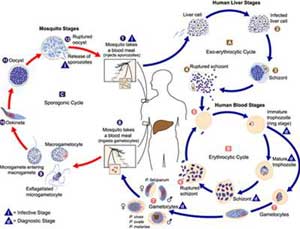Malaria in children

Life cycle of malaria
Malaria is a disease rarely spread from person to person, from mother to child or through blood transfusions, organ transplants or sharing needles. It is mainly transmitted by mosquito bites that previously burned people with malaria.
Signs and symptoms
A child with malaria may have early symptoms such as irritability, drowsiness, poor appetite and sleep problems. The symptoms that follow are often chills, followed by fever and shortness of breath. The fever may be slowly for 1, 2 days or may be suddenly high to 105 degrees C or higher. Then, when the fever subsided and body temperature quickly returned to normal, the child began to sweat a lot.
Symptoms such as chills, fever, and sweating can be repeated over a period of 2 or 3 days, depending on the malaria parasite causing the disease. Because the initial symptoms are often unclear and may be mistaken for other diseases, malaria is difficult to diagnose.
Other symptoms of malaria include headache, nausea, and aches all over the body, especially the unusually enlarged abdomen and back and spleen. When malaria affects the brain, the child may have a seizure or coma. If malaria affects the kidneys, the production of urea will be abnormally low.
Worldwide, there are 300-500 million people infected with malaria each year. Most occur in sub-Saharan Africa, with about 2 million people dying each year from malaria.
When the malaria parasites enter the bloodstream, they will go to the liver, where they increase many times. Every few days, thousands of parasites are released from the liver into the bloodstream, where they destroy red blood cells. Some parasites stay in the liver, continue to proliferate and release more parasites into the blood every few days.
The incubation period of malaria is the time from mosquito bites until the parasite is released from the liver. This period varies depending on the type of malaria parasite that causes the disease. Overall, it ranges from 10 days to 1 month.
Preventing malaria
Health professionals try to prevent malaria with mosquito control programs to kill mosquitoes - carriers and disease carriers. If you go to areas with high rates of malaria, you should install windows with screens, use mosquito repellent, and mosquito nets when sleeping.
Ask your doctor for advice before going to tropical or subtropical areas at high risk of malaria, you may be given anti-malarial drugs to prevent the disease.
There are many types of vaccines against malaria that have been studied and tested around the world, but because there are many different stages in the life cycle of malaria parasites, the development of these vaccines is quite difficult. Therefore, the best way is to avoid mosquito bites.
T.VY
- How to diagnose, treat and prevent malaria
- Malaria changes the smell of patients, makes them more
- Trial of malaria vaccine failed
- Successfully tested the vaccine against malaria
- The first vaccine against malaria loses its effectiveness after 4 years of injection
- A malaria vaccine has been developed
- A breakthrough in preparing malaria vaccines
- Important findings pave the way for antimalarial drugs
- New way to kill malaria parasites
- South Africa: The climate warms up again with the outbreak of malaria
- The trial of malaria vaccine achieved positive results
- Conduct a trial on human malaria vaccine
 Green tea cleans teeth better than mouthwash?
Green tea cleans teeth better than mouthwash? Death kiss: This is why you should not let anyone kiss your baby's lips
Death kiss: This is why you should not let anyone kiss your baby's lips What is salmonellosis?
What is salmonellosis? Caution should be exercised when using aloe vera through eating and drinking
Caution should be exercised when using aloe vera through eating and drinking